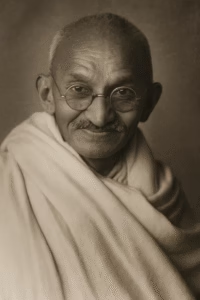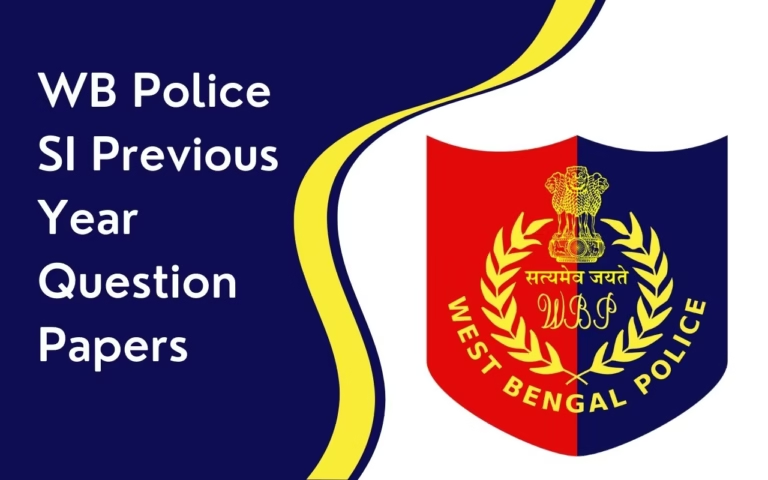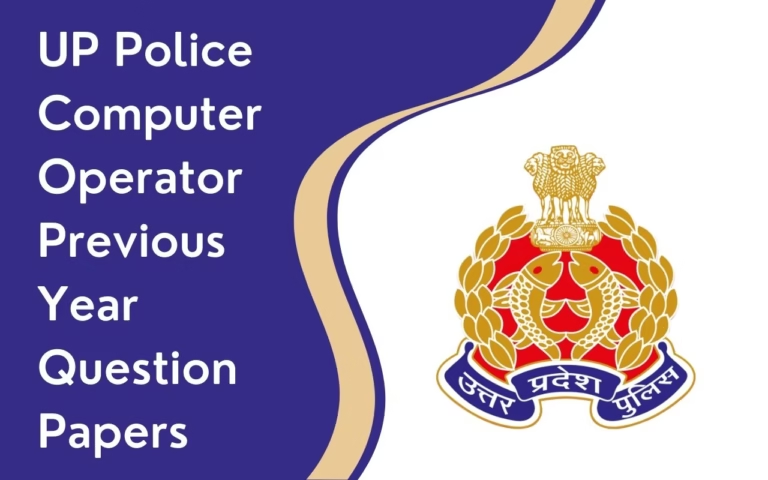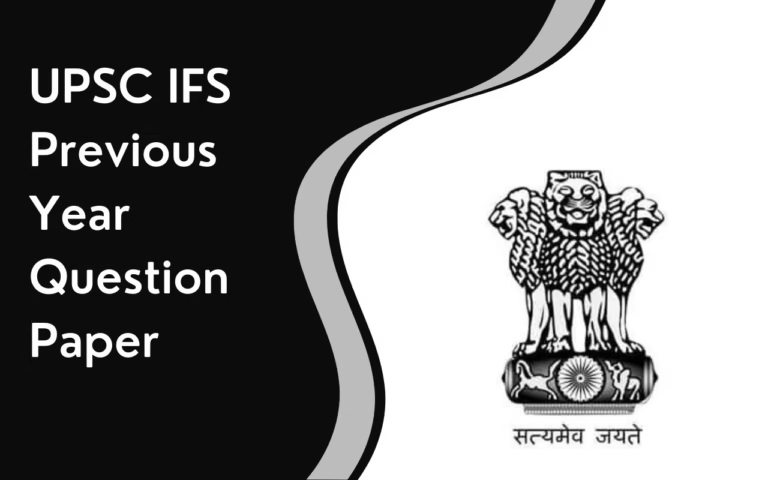Mahatma Gandhi Biography: Mahatma Gandhi, also known as Mohandas Karamchand Gandhi, was born on October 2, 1869, in Porbandar, Gujarat, India. He was a renowned figure in modern history and is often referred to as the Father of the Nation. Many people lovingly referred to him as Bapu. His movements and political career had a wide impact not only in India but also across the world.
People called him Mahatma, which means “Great Soul.” He was a guiding light in India’s struggle for independence from British rule. Mahatma Gandhi’s teachings of self-reliance and non-violence had a profound influence on many people around him. Let’s look in detail at Mahatma Gandhi’s Biography, the struggles he faced, and his fight for independence.
Mahatma Gandhi Biography
Mohandas Karamchand Gandhi was a famous freedom fighter and social reformer who played a role in India’s struggle for independence. Whenever he walked, people followed him with respect and believed in his ideas. He is called the Father of the Nation. Gandhiji worked hard to improve the lives of the poor and promoted truth, non-violence, and equality.
Every year on October 2nd, we celebrate his birthday as Gandhi Jayanti, which is a national holiday in India. His teachings inspired not only Indians but also world leaders like Martin Luther King Jr. and Nelson Mandela in their own struggles for justice and freedom.
Gandhiji believed in simple living and high thinking. His popularity was so great that wherever he went, crowds gathered just to see him. He led major movements like the Salt March and the Quit India Movement, showing the power of peaceful protest. Mahatma Gandhi’s legacy continues to inspire people around the world even today.
Mahatma Gandhi Biography Overview – Birth, Family, Movements, Death & Legacy
| Feature | Details |
|---|---|
| Full Name | Mohandas Karamchand Gandhi |
| Popular Name / Title | Mahatma Gandhi (Father of the Nation) |
| Date of Birth | 2 October 1869 |
| Place of Birth | Porbandar, Gujarat, India |
| Date of Death | 30 January 1948 (aged 78) |
| Place of Death | Delhi, India |
| Cause of Death | Assassination (shot by Nathuram Godse) |
| Nationality | Indian |
| Political Affiliation | Indian National Congress |
| Professions | Lawyer, Political Leader, Freedom Fighter, Writer, Social Reformer |
| Father | Karamchand Gandhi |
| Mother | Putlibai Gandhi |
| Spouse | Kasturba Gandhi |
| Children | Harilal, Manilal, Ramdas, and Devdas Gandhi |
| Major Movements Led |
|
| Famous Works / Writings | My Experiments with Truth, Hind Swaraj |
| Global Influence | Inspired civil rights leaders like Martin Luther King Jr. and Nelson Mandela |
| Education | Studied law at University College London |
| Important Conferences Attended | Round Table Conferences (1931–1932) |
| Legacy | Symbol of peace, non-violence, and truth worldwide |
Mahatma Gandhi Biography: Early Life and Education
Mohandas Karamchand Gandhi, also known as Bapu, was born on October 2, 1869, in Porbandar, Gujarat, India. His father, Karamchand Gandhi, was the Diwan (chief minister) of Porbandar, and his mother, Putlibai, was deeply religious, often fasting and praying. These early exposures to spirituality and discipline shaped young Gandhi’s moral compass.
Childhood Traits and Early Influences
Gandhi was a shy and introspective child. He was not so good in his academic studies, but was of honest and simple person. He was widely influenced by the Stories of Shravana and Harishchandra, known for their devotion and truthfulness, which left a lasting impression on his young mind.
Gandhi attended local schools in Rajkot and Porbandar. He completed matriculation at age 16 before moving abroad for higher studies.
Studies in London
In 1888, Gandhi sailed to London to study law at the Inner Temple. During his stay, he adapted to British culture, became a vegetarian, and read religious texts including the Bhagavad Gita, Bible, and Tao Te Ching, which broadened his philosophical horizons.
Influences of Western Philosophy
While in London, Gandhi was influenced by thinkers like Leo Tolstoy, Henry David Thoreau, and John Ruskin. Their thoughts on civil disobedience, non-violence, and social justice deeply impacted his ideology.
Also Check: C Sankaran Nair Biography
Gandhi’s Personal Life
Marriage to Kasturba Gandhi – Gandhiji Married to Kasturba Makhanji at the age of 13, in a traditional arranged marriage. Their bond grew stronger over time, and Kasturba later became an active participant in his political struggles.
Children and Family Life – The couple had four sons. Despite the demands of public life, Gandhi maintained a strong connection with his family, though not without criticism for his strict parenting and personal experiments in celibacy and simplicity.
Personal Beliefs and Ethics – Gandhi practiced brahmacharya (celibacy), followed a strict vegetarian diet, and lived a minimalist lifestyle. His commitment to truth and non-violence became the foundation of his public life.
Mahatma Gandhi’s Journey in South Africa
Introduction to Racial Discrimination
In 1893, Gandhi went to South Africa as a legal advisor. His life changed when he was thrown off a train for refusing to move from a whites-only compartment. This incident awakened his fight against racial injustice.
Founding of Natal Indian Congress
To protect the rights of Indians, Gandhi founded the Natal Indian Congress in 1894, uniting the Indian community in peaceful protests and legal action.
Satyagraha Movement in South Africa
He coined Satyagraha, meaning “truth-force,” advocating non-violent resistance. This powerful philosophy became the core of his lifelong mission and led to major successes in South Africa before his return to India in 1915.
Return to India and National Awakening
Upon his return, Gandhi observed widespread poverty and discontent under British rule. He was deeply disturbed by the exploitation and began connecting with local peasants and workers.
Joining the Indian National Congress
Gandhi officially joined the Indian National Congress and soon became its most influential leader, advocating for self-rule (Swaraj) and uplifting the poor.
Major Movements Led by Mahatma Gandhi
1. Champaran Satyagraha (1917)
Mahatma Gandhi’s first major struggle in India was in Champaran, Bihar. Farmers were forced to grow indigo and give most of it to British landlords. Gandhi stood with the farmers and used non-violent methods to protest. This led to the end of the cruel tinkathia system, giving relief to the farmers and marking Gandhi’s entry into Indian politics.
2. Kheda Movement (1918)
In Kheda, Gujarat, people were facing a famine, and still, the British were collecting taxes. Gandhi led a peaceful protest asking the government to waive the taxes. With public support and unity, the movement succeeded, and the British agreed to cancel the tax. This event strengthened Gandhi’s image as a leader who cared for the poor.
3. Non-Cooperation Movement (1920–1922)
Gandhi launched this movement to make Indians stop helping the British government. People were asked to boycott British schools, courts, goods, and titles. The aim was to weaken British control without using violence. However, when a violent incident happened at Chauri Chaura, Gandhi called off the movement, showing his commitment to non-violence.
4. Civil Disobedience Movement (1930–1934)
This movement began with the famous Salt March, where Gandhi walked 240 miles to the sea at Dandi to make salt illegally. This was a direct challenge to British laws. Many Indians followed his example and refused to follow British rules peacefully. It became a mass movement and put more pressure on the British government.
5. Quit India Movement (1942)
In 1942, during World War II, Gandhi gave the powerful slogan “Do or Die” and started the Quit India Movement. It demanded that the British leave India immediately. Although Gandhi and many leaders were arrested, people across the country rose up in protest. This was one of the final major steps toward India’s independence.
Gandhi’s Philosophy and Principles
- Non-Violence (Ahimsa)
Gandhi believed non-violence was not cowardice, but the greatest force at the disposal of mankind. He applied this principle in all his campaigns, making it central to his ideology. - Truth (Satya)
Gandhi saw truth as God. He believed in living truthfully in word, action, and intention. This personal and political commitment earned him deep respect globally. - Self-Reliance (Swadeshi)
He encouraged Indians to wear khadi and boycott foreign goods. Swadeshi was not just economic resistance, but a path to self-dignity and national unity.
Gandhi’s Role in India’s Freedom Movement
- Peaceful Fight for Freedom
Mahatma Gandhi played a powerful role in India’s fight for independence. He used nonviolence and truth as his main weapons, which deeply troubled the British rulers. His peaceful protests, like the Salt March and Quit India Movement, united people from all walks of life, including women and villagers, making the movement strong and nationwide. - Talks with the British
Even though Gandhi was jailed many times, he never stopped trying to solve things peacefully. He spoke to British leaders in important meetings like the Round Table Conferences. His calm yet firm way of speaking surprised many British officials and won him great respect. - India’s Independence in 1947
India finally became free on August 15, 1947, after many years of struggle. Gandhi did not take part in the big celebrations, but he remained the guiding light and moral leader who inspired the whole journey to freedom.
Relationship with Other National Leaders
- Nehru, Patel, and Ambedkar – Gandhi shared deep yet complex relationships with fellow leaders:
- Jawaharlal Nehru: Shared admiration and ideological debates, especially on modernity vs. tradition.
- Sardar Patel: Trusted lieutenant, especially on administrative matters.
- Dr. B.R. Ambedkar: Clashed over caste issues, particularly the Poona Pact, but shared mutual respect.
Gandhi’s Conflicts and Collaborations – Struggles & Allies in Freedom Movement
While Gandhi emphasized moral transformation, others like Subhas Chandra Bose favored military action. Despite differences, Gandhi remained a unifying figure.
Gandhi’s Influence on the World
Inspiration to Martin Luther King Jr. – The American civil rights leader adopted Gandhi’s philosophy of non-violence to fight racial segregation in the USA.
Influence on Nelson Mandela and Others – In South Africa, Nelson Mandela drew strength from Gandhi’s example during his own anti-apartheid struggle. Leaders across Latin America, Europe, and Asia cite Gandhi as a beacon of moral courage.
Mahatma Gandhi Assassination and Aftermath
Events Leading to Assassination: After Partition, Gandhi tried to unite Hindus and Muslims, which angered Hindu extremists. On January 30, 1948, he was shot dead by Nathuram Godse in Delhi.
Reactions in India and Worldwide: His death shocked the world. India mourned the loss of the “Father of the Nation.” Leaders like Einstein, Churchill, and Roosevelt paid tribute to his unmatched legacy.
Legacy of Mahatma Gandhi: Many Educational Institutions were made in His Name. Numerous schools, universities, and research centers globally are named after Gandhi, including Gandhigram Rural Institute and Mahatma Gandhi University.
October 2 is observed as Gandhi Jayanti in India and International Day of Non-Violence by the UN. Gandhi’s ideals remain crucial in today’s world, plagued by violence and inequality. Movements for environmental justice, peace, and civil rights still draw inspiration from him.
Best Books on Mahatma Gandhi – Autobiographies, Biographies & Life Stories
| Book Title | Author | Description |
|---|---|---|
| The Story of My Experiments with Truth | Mahatma Gandhi | Autobiography of Gandhi; covers his early life, South Africa, and the independence movement. |
| Gandhi: An Autobiography | Mahatma Gandhi (translated by Mahadev Desai) | English version of Gandhi’s autobiography. |
| Gandhi Before India | Ramachandra Guha | Focuses on Gandhi’s early life and time in South Africa. |
| Gandhi: The Years That Changed the World (1914–1948) | Ramachandra Guha | Covers Gandhi’s return to India and his political journey. |
| Great Soul: Mahatma Gandhi and His Struggle with India | Joseph Lelyveld | A detailed and critical biography of Gandhi’s life. |
| Mahatma Gandhi: His Life and Times | Louis Fischer | A classic biography by an American journalist who met Gandhi. |
| Gandhi: A Political and Spiritual Life | Kathryn Tidrick | Highlights both the political and spiritual aspects of Gandhi’s life. |
| Gandhi the Man: How One Man Changed Himself to Change the World | Eknath Easwaran | Focuses on Gandhi’s personal transformation and inner strength. |
Gandhi’s Portrayal in Media and Literature
Biographies and Documentaries
Several writers, including Louis Fischer, Rajmohan Gandhi, and Judith Brown, have documented his life.
Films and Theater Adaptations
The Oscar-winning film “Gandhi” (1982) by Richard Attenborough remains the most well-known cinematic portrayal. Gandhi has been portrayed in stage plays, cartoons, and educational series worldwide.
महात्मा गांधी की जीवनी (Mahatma Gandhi Biography in Hindi)
महात्मा गांधी का जन्म 2 अक्टूबर 1869 को गुजरात के पोरबंदर शहर में हुआ था। उनका पूरा नाम मोहनदास करमचंद गांधी था। उनके पिता करमचंद गांधी एक दीवान थे और माता पुतलीबाई धार्मिक विचारों वाली महिला थीं। बचपन से ही गांधी जी शांत, ईमानदार और सत्यवादी स्वभाव के थे। उन्होंने अपनी प्रारंभिक शिक्षा पोरबंदर और राजकोट में पूरी की। आगे की पढ़ाई के लिए वे इंग्लैंड गए, जहां से उन्होंने कानून की डिग्री प्राप्त की। वकालत के लिए वे दक्षिण अफ्रीका गए, जहां उन्हें रंगभेद का सामना करना पड़ा। वहीं से उन्होंने अन्याय के खिलाफ सत्याग्रह और अहिंसा का रास्ता अपनाया।
1915 में गांधी जी भारत लौटे और आजादी की लड़ाई में कूद पड़े। उन्होंने देशवासियों को अंग्रेजों के खिलाफ शांतिपूर्ण ढंग से लड़ने के लिए प्रेरित किया। उन्होंने कई आंदोलनों का नेतृत्व किया, जैसे – चंपारण सत्याग्रह, असहयोग आंदोलन, नमक सत्याग्रह और भारत छोड़ो आंदोलन। गांधी जी का विश्वास था कि सत्य और अहिंसा के मार्ग पर चलकर ही सच्ची आज़ादी मिल सकती है। वे स्वदेशी वस्तुओं के प्रयोग और सादा जीवन में विश्वास रखते थे। उनके विचार और कार्यों ने न केवल भारत को आज़ादी दिलाई, बल्कि पूरी दुनिया को अहिंसा का संदेश भी दिया।
30 जनवरी 1948 को गांधी जी की हत्या नाथूराम गोडसे ने कर दी। उनकी मृत्यु से पूरे देश को गहरा आघात पहुंचा। महात्मा गांधी को ‘राष्ट्रपिता’ की उपाधि दी गई और उनका जन्मदिन 2 अक्टूबर को हर साल ‘गांधी जयंती’ के रूप में मनाया जाता है। गांधी जी का जीवन आज भी लोगों के लिए प्रेरणा है और उनके सिद्धांत – सत्य, अहिंसा और सादा जीवन – हमें एक बेहतर समाज की ओर ले जाते हैं।
महत्वपूर्ण कीवर्ड्स: महात्मा गांधी जीवनी, गांधी जयंती, स्वतंत्रता संग्राम, सत्य और अहिंसा, राष्ट्रपिता, भारत छोड़ो आंदोलन, दांडी मार्च, गांधी का विचार, महात्मा गांधी का जीवन.
Conclusion
Mahatma Gandhi’s biography is more than a story of one man—it’s a chronicle of truth, courage, and change. His principles of non-violence, self-discipline, and unity are timeless. In a world that constantly grapples with conflict and division, Gandhi’s life remains a beacon of hope and humanity.
Mahatma Gandhi Biography Frequently Asked Questions (FAQs)
When was Mahatma Gandhi’s autobiography first published?
The autobiography was first published in 1927, and it still inspires millions of people around the world.
Where did Gandhi write most parts of his autobiography?
He wrote it while staying at Sabarmati Ashram and during his time in prison, reflecting deeply on his past.
How can Mahatma Gandhi biography inspire today’s youth?
Mahatma Gandhi biography inspires youth to follow the path of peace, integrity, and justice, showing that change starts with small, truthful actions.
What was Gandhi’s biggest achievement?
Gandhiji Biggest achievement was to unite diverse Indians into a peaceful struggle and influence global civil rights movements.
Did Gandhi win any Nobel Peace Prize?
Though nominated several times, he never received it, which is widely considered a major oversight.
Who translated Gandhi's autobiography into English?
Mahadev Desai, who was Gandhi’s close associate and secretary, translated the autobiography from Gujarati to English.
What are the main themes in Mahatma Gandhi biography?
The main themes include truth, non-violence (Ahimsa), self-discipline, and spiritual growth through real-life experiences.
What were Gandhi’s last words?
Gandhi’s last words were Hey Ram reflecting his lifelong devotion to God.




